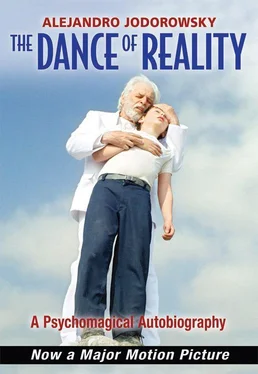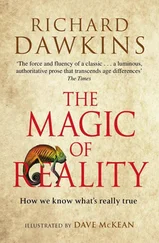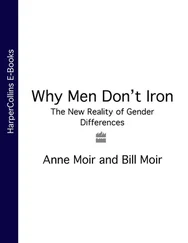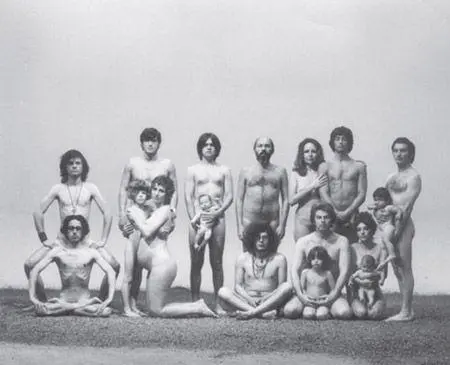
The cast of my theatrical work Zaratustra (Mexico, 1976). From left to right, back row: Henry West (musician); Héctor Bonilla (actor);Mickey Salas (musician), with his son; Carlos Áncira (actor); IselaVega (actress); Jorge Luque (actor); and Álvaro Carcaño (actor), with his son. Front row: Luis Urías (musician); Brontis Jodorowsky; Valérie Trumblay (in her womb, Teo Jodorowsky); El Greñas (seller of programs for the play); Alejandro Jodorowsky with Axel Cristóbal Jodorowsky; and Susana Camini (actress), with her son.
I wondered, Would it be possible for the theater to dispense with the actors? And, Why not the audience? The theater building seemed limited, useless, outdated. A show could be created anywhere, on a bus, in a cemetery, in a tree. It was useless to interpret a character. The person acting — not an actor — should not be putting on a spectacle to escape from himself, but to reestablish contact with the mystery within. The theater ceased to be a distraction and became an instrument of self-knowledge. I replaced the creation of written works with what I called the “ephemeral.”
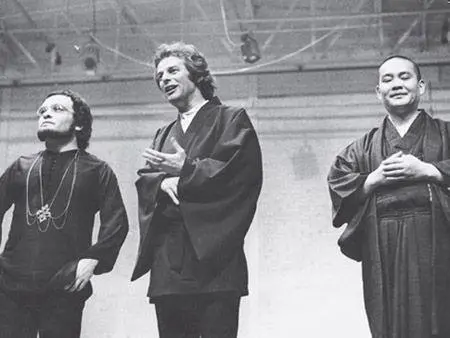
During the performance of Zaratustra in Mexico, with Fernando Arrabal and the Zen master Ejo Takata. Photo: Hermanos Mayo.
During a performance an actor should completely melt into the “character,” fooling himself and others with such mastery as to misplace his own “person” and become another, a character with concise limits, made from sheer imagination. In the ephemeral, the acting person should eliminate the personality and attempt to be the person he is playing. In everyday life so-called normal people walk around in disguise, playing a character that has been inculcated by family, by society, or that they themselves have fabricated: a mask of pretense and bluster. The mission of the ephemeral was to make the individual cease to play a character in front of other characters, and ultimately to eliminate that character and suddenly become closer to the true person. This “other” who awakes amidst the euphoria of free action is not a puppet made of lies, but a being with minor limitations. The ephemeral act leads to the whole, to the release of higher forces, to a state of grace.
Without my realizing it, this exploration of the intimate mystery was the beginning of a therapeutic theater that ultimately led me to the creation of psychomagic. If I did not imagine this at the time, it was because I thought that what I was doing was a development of theatrical art. Before happenings began in the United States, I put on spectacles that could take place only once; I introduced perishable things like smoke, fruit, gelatin, the destruction of objects, baths of blood, explosions, burns, and so on. Once we performed in a place where two thousand chickens were clucking; another time we sawed through a double bass and two violins. I proceeded by searching for a place that someone would let me use, any sort of place, as long as it was not a theater: a painting academy, an asylum for the mentally ill, a hospital. Then I persuaded a group of people I knew, preferably not actors, to participate in a public presentation. Many people have an act in their soul that ordinary conditions do not allow them to carry out, but under favorable circumstances they rarely hesitate when offered the opportunity to express what sleeps within them. For me, an ephemeral had to be free to attend, like a party: when we staged them, we did not charge the guests for food or drinks. All the money I could save was invested in these presentations. I would ask the participant what he wanted to expose, then give him the means to do so. The painter Manuel Felguérez decided to slaughter a hen in front of the spectators and do an abstract painting on the spot using its guts, while at his side wearing a Nazi soldier’s uniform was his wife Lilia Carrillo, also a painter, who devoured a grilled chicken. A young actress who later became famous, Meche Carreño, wanted to dance naked to the sound of an African rhythm while a bearded man covered her body with shaving cream. Another woman wanted to appear as a classical dancer in a tutu without underwear and urinate while interpreting the death of a swan. An architecture student decided to appear with a mannequin and beat it violently, then pull several feet of linked sausages out from the crushed pubic area. One student came dressed as a university professor carrying a basket full of eggs and proceeded to smash one egg after another on his forehead while reciting algebraic formulas. Another, dressed as a cowboy, arrived with a large copper basin and several liters of milk. Lying in the container in a fetal position he recited an incestuous poem dedicated to his mother as he emptied the milk bottles, drinking the contents. A woman with long blond hair arrived walking on crutches and screaming at the top of her lungs, “My father is innocent, I am not!” At the same time she took pieces of raw meat from between her breasts and threw them at the audience. Then she sat down on a child’s chair and had her head shaved by a black barber. In front of her was a crib full of doll heads without eyes or hair. With her skull bare, she threw the heads at the audience, screaming, “It’s me!” A man dressed as a bridegroom pushed a bathtub full of blood onto the platform. A beautiful woman dressed as a bride followed him. He began to fondle her breasts, crotch, and legs, and finally, getting more and more excited, submerged her in the blood along with her ample white dress. He then rubbed her with a large octopus while she sang an aria from an opera. A woman with a great deal of red hair, pale skin, and a gold dress that clung close to her body appeared with a pair of shears in her hands. Several brown-skinned boys crept toward her, each one offering her a banana, which she sliced while laughing out loud.
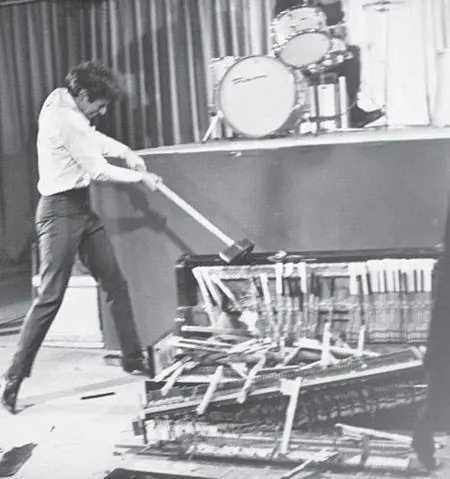
Smashing a piano on Mexican television, in 1969.
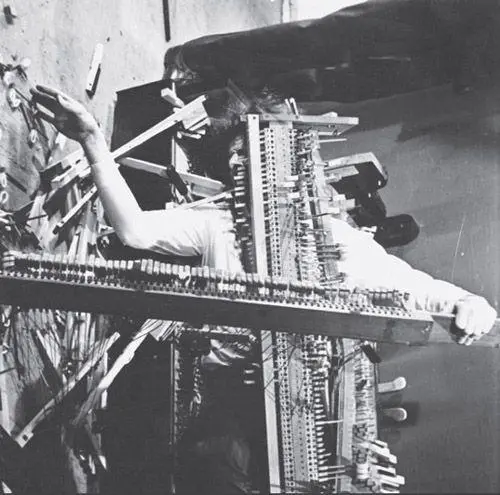
Destruction and restoration of a piano.
All of these acts, these true delusions, were conceived and realized by persons considered normal in real life. The destructive energies that eat away at us from the inside when they are left stagnant can be released through channeled and transformative expression. Once the alchemy of the act is accomplished, the anguish is transmuted into euphoria.
The ephemeral panics were conducted without publicity, with the place and time given out at the last minute. On average about four hundred people would attend through this system of word of mouth. Thankfully, no articles about them were published in the newspapers. The government’s office of performances, headed by an infamous bureaucrat named Peredo, exerted an imbecilic form of censorship. In one theatrical work I was forced to hide a character’s belly button. In another, the actor Carlos Ancira wore a cape with two balls about the size of soccer balls hanging at the bottom; the troublesome civil servant considered them too suggestive of testicles and made us remove them. Thanks to the discrete and free nature of our ephemerals, we were able to express ourselves without any problem. The reaction was very different when I was invited to perform one on national television.
Читать дальше
